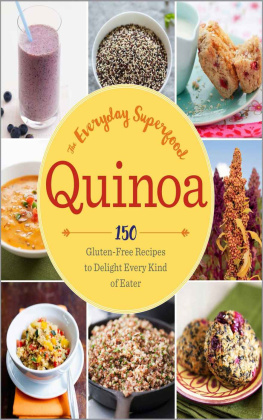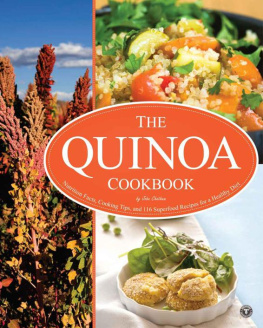Alive | Natural Health Guides |
Quinoa
HIGH PROTEIN, GLUTEN-FREE
Beth Geisler
with recipes by Jo Stepaniak

CONTENTS
Note: Conversions in this book (from imperial to metric) are not exact. They have been rounded to the nearest measurement for convenience. Exact measurements are given in imperial. The recipes in this book are by no means to be taken as therapeutic. They simply promote the philosophy of both the authors and Books Alive in relation to whole foods, health, and nutrition, while incorporating the practical advice given by the authors in the first section of the book.
It is your constitutional right to educate yourself in health and medical knowledge, to seek helpful information, and to make use of it for your own benefit and for that of your family. You are the one responsible for your health. In order to make decisions in all health matters, you must educate yourself. With this book and the guidance of a naturopath or alternative medical doctor, you will learn what is needed to achieve optimal health.
Those individuals currently taking pharmaceutical prescription drugs will want to talk to their healthcare professionals about the negative effects that the drugs can have on herbal remedies and nutritional supplements, before combining them.

INTRODUCING QUINOA
In North America, the conversation about quinoa, an ancient grain from South America, started in the 1980s when it was first imported. And its been heating up ever since. Thats because this nutritious food is high in protein, has an outstanding amino acid profile, is lower in carbohydrates than other whole grains, and is rich in minerals and vitamins. These, among other nutrition advantages, have earned quinoa the nicknames superfood and supergrain.
Quinoas flavor, often described as nutty, is mellow and comforting, and its texture is fluffy and sometimes a bit crunchy depending on the type of quinoa and how well its been cooked. Light and easy to digest, the grain is exceptionally versatile and can provide endless variety in any cooks repertoire. It can be substituted for almost any other grain, such as rice, couscous, barley, millet, and bulgur. It can also be an alternative to pasta and potatoes. Commercially, quinoa is available in many forms, including cold breakfast cereals, flakes, flour, and gluten-free pasta.
The first task for a person who is new to quinoa is to learn how to properly say the namethe word is pronounced KEEN-wah. The next is to discover all the reasons this superfood is cropping up all over. Now widely available in natural food stores, supermarkets, and online outlets, quinoa meets the needs of consumers who seek an organically grown, hypoallergenic, gluten-free whole grain. These attributes mean that quinoa is unlikely to trigger food allergies and is suitable for people who cant eat wheat or other cereal grains.

Quinoa is exported mostly from Bolivia and Peru, where its still sustainably grown by farming families and is sown by hand, weeded by hand, harvested by hand, and threshed by hand. A number of brands on the market are fair-trade products, available in North America through the collaboration of farmers, farming collectives, and selective importers.
Considered to be a nutritionally complete plant-based food, quinoa has been a favorite among vegetarians and vegans for some time. But it has quickly moved into the mainstream, and savvy cooks everywhere are introducing it to their friends and families. As its popularity grows, quinoa is gaining attention, and not just at dinner parties. This nutritious crop has been noticed by organizations that recognize its potential for the future. For example, the United Nations sees it as a crop that could alleviate hunger and malnutrition because it can be grown in arid regions where other crops wont survive. In addition, the National Aeronautics and Space Administration (NASA) has studied quinoa as a food source that could be grown on long-term manned space flights, providing nutrition and sustenance to the crew.

A Seed, Not a True Grain
Technically, quinoa (Chenopodium quinoa) is not a true grain but the seed of a plant in the goosefoot family. Its relatives include not only common food crops, such as beets, chard, and spinach, but also wild plants, such as lambs-quarters, which grows abundantly throughout North America. As a seed crop, quinoa, like amaranth and buckwheat, is sometimes referred to as a pseudograin or pseudocereal because its used like a grain and is nutritionally similar. Often, however, quinoa is simply called a grain, and thats the term used throughout this book.
Most grains, such as wheat, oats, barley, and rye, come from plants that are members of the grass species. And just like grains from the grass family, quinoa can be easily ground into flour. Grains and pseudograins are excellent sources of energy and protein. In fact, quinoa has up to twice the amount of protein as many grains.
Flat, irregularly shaped, and quite small, quinoa seeds are about the size of millet or sesame seeds. A close look will reveal the reason for the seeds unusual shapelike all whole grains, quinoa has a germ. This tail-like germ protrudes slightly in the dry grain; when cooked in liquid, the germ curls around the grain like a tiny halo.
Quinoa seeds grow in large clusters at the top of the plants tall, magenta stalk, and a field planted with quinoa can reveal a riot of brilliant color. The flowering plant can feature blossoms that range from crimson to orange to violet, and the seed heads can be green, orange, pink, purple, red, or yellow. Once the seed head is dried, the tiny quinoa seeds are simply shaken out and dried. The next step removes some of the seeds brilliant color, which is caused by a natural resin that acts as the plants own defense system against birds and insects that would feast on the seeds. Because of this natural resinous coating, quinoa can be grown without chemical pesticides. The resin, which may even protect the seeds from the extreme heat theyre exposed to at high altitudes, contains 2 to 6 percent saponin, a mild toxin that produces a soapy lather. When the resin is removed from the quinoa, the color may also be stripped away, leaving the white, red, and black quinoa varieties that are sold commercially.
The saponin-containing resin causes quinoa to taste bitter, and most growers remove it either by soaking the seeds in water or by using machinery similar to a rice polisher. Nonetheless, although many brands say theyre prerinsed, quinoa should always be soaked or rinsed before cooking to avoid potential bitterness. The cooking technique recommended in this book includes a brief soaking, which helps to remove any residual saponin. After the quinoa has been soaked, simply put it in a fine-mesh strainer and thoroughly rinse it for a few moments to ensure that any saponin has been removed; that will be evident when the rinse water no longer foams or produces lather.
Next page

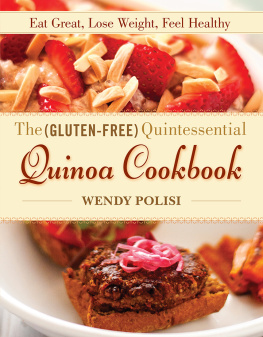
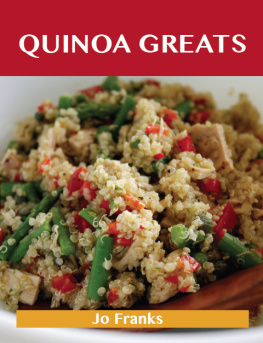
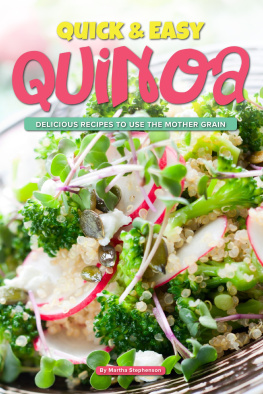
![Sacasa - The Quinoa [Keen-Wah] Cookbook](/uploads/posts/book/233264/thumbs/sacasa-the-quinoa-keen-wah-cookbook.jpg)

